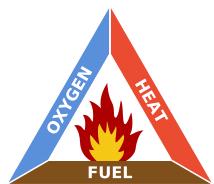Fires start when a flammable and/or a combustible material with an adequate supply of oxygen or another oxidizer is subjected to enough heat. For a fire to exist it requires three elements to be in place Heat, Oxygen and Fuel. This is known as the Fire Triangle.

Fire triangle and the three ingredients necessary for most fires
The triangle illustrates the rule that in order to ignite and burn, a fire requires these three elements. The fire is prevented or extinguished by removing any one of them. A fire naturally occurs when the elements are combined in the right mixture
- Without sufficient heat, a fire cannot begin, and it cannot continue. Heat can be removed by dousing with water; the water turns to steam and the steam is further heated, taking the heat with it.
- Without fuel, a fire will stop. Fuel can be removed naturally, as where the fire has consumed all the burnable fuel, or manually, by mechanically or chemically removing the fuel from the fire.
- Without sufficient Oxygen, a fire cannot begin, and it cannot continue. With a decreased oxygen concentration, the combustion velocity gets lower.
Classification of Fire

Fire Classification
In firefighting, fires are identified according to one or more fire classes. Each class designates the fuel involved in the fire, and thus the most appropriate extinguishing agent. Fires have been classified into four groups A, B, C, & D.
- Class A fires – are fires involving organic solids like paper, wood, etc
- Class B fires – are fires involving flammable liquids.
- Class C fires – are fires involving flammable gasses
- Class D fires – are fires involving metals
- Class F fires – are fires involving cooking oil fats
Electrical fires Electrical fires are not considered to constitute a fire class on their own, as electricity is a source of ignition that will feed the fire until removed. When the electricity supply has been isolated, the fire can be treated (generally) as ‘Class A’ for extinguishing purposes. However, the electrical supply must be isolated before fighting the fire. In addition it must be remembered that certain electrical apparatus maintains a lethal charge for some time after it has been switch off. Always use extinguishers containing a non-electrical conducting extinguishing agent specifically designed for use on electrical equipment such as Carbon Dioxide (CO2) or Dry Powder.